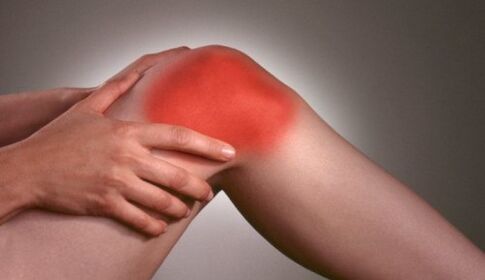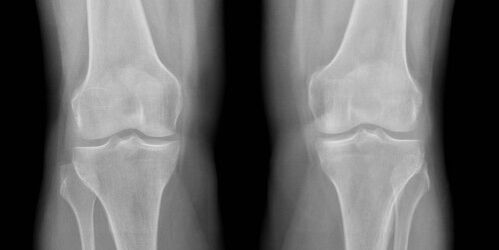Osteoarthritis of the knee joint (gonarthrosis) is a disease that causes deformity of the cartilage of the knee joint. The disease is very common, especially among the older generation. Knee work worsens, and therefore difficulty in movement and sensation of pain are the most important signs of the disease. Today, arthrosis of the knee joint is also common among people aged 25-30 years. What to talk about the versatility of the causes of the disease and, consequently, its treatment. >There are two types of gonarthrosis: unilateral (affecting only one knee) and bilateral (affecting both knees). More often the disease occurs in bilateral manifestations.

The reasons
Gonarthrosis, like coxarthrosis, most often manifests itself in old age. Although no exception today and the fact that young people have symptoms of this disease. This suggests that the causes of gonarthrosis are different and each can in its own way affect the appearance, severity and treatment of the disease. There is also the possibility of genetic predisposition of the organism, viz. Arthrosis of the knee joint may be more common in some families than others. In addition, the disease may not be genetically determined. Therefore, there are several causes of gonarthrosis.
- Various physical injuries of the knee (bruises, dislocations, etc. ).
- Large loads that are not appropriate for age (5-7% of all cases of gonarthrosis, as well as coxarthrosis).
- Overweight patients (10% of all cases of gonarthrosis).
- Diseases that accompany, for example, arthritis (5-7% of all cases of gonarthrosis, polyarthrosis and coxarthrosis).
- Congenital ligament weakness (3-5% of gonarthrosis cases).
- Metabolic syndrome and metabolic problems in the body.
- Upper thigh muscle spasm (up to 50% of cases of gonarthrosis and coxarthrosis).

symptoms
The symptoms of osteoarthritis of the knee joint are mostly the same, and appear in almost all patients. Patients also note that pain worsening falls during the spring-autumn period and depends on weather changes. The main symptom of this disease is knee pain. Often, it does not appear immediately, but appears only after a long walk and appears in the late afternoon. Bells can cause stiffness in the knee when moving. If minor symptoms are left unattended, then the disease can be triggered, and it can bring very undesirable results for the patient. Despite the main symptoms, there are several other signs of the disease:
- pain syndrome at rest, which is qualitatively reduced when walking;
- limitation of movement of the knee joint and difficulty controlling its mobility;
- knee stiffness;
- increased sensitivity in the knee area;
- swelling of the knee joint and swelling of the surrounding skin;
- knee joint deformity.
Assessment of the condition of the knee joint is done during a doctor’s examination and X-ray. Moreover, the stage of the disease of any arthrosis (including coxarthrosis, gonarthrosis, polyarthrosis etc. ) can only be determined if there is an x-ray and only a doctor can make an assessment of such a condition. Therefore, it is very important not to engage in self -diagnosis and not to draw conclusions.
Stages of gonarthrosis
first degree
The knee joint is not subject to the influence of disease deformities, but only appears with external signs and slight swelling of the periarticular skin, a change in its color is noticeable. At the physiological level, it is characterized by small changes in hyaline cartilage. As a result of the accumulation of large amounts of joint fluid in the synovin, small joint deformities occur, which are accompanied by pain when walking. Other signs such as limited mobility were not observed. Therefore, it is also difficult to detect it on radiographs. At this stage, the disease is difficult to diagnose, but with rapid definition, its treatment will be more effective than with other or third degree gonarthrosis, as well as other types of arthrosis (coxarthrosis, polyarthrosis).
II degree
The main symptom is unbearable or intense pain, even with a slight load, which is exacerbated by walking and lifting weights. Over time, this will develop into difficulty bending the knee. At the physiological level, this is indicated by the fact that the number of layers of cartilage decreases sharply, and in some places is not fully present. According to the x-ray results, this level can be determined by marginal bone growth and joint space density. In joint work, especially with long walks, characteristic irritation appears. Gradually, the patient may lose the ability to bend the knee, or it will be given to him with difficulty. The effects of deformation are already evident at this stage of development of gonarthrosis, as well as other types of arthrosis (coxarthrosis, polyarthrosis). Visually, this is noticeable, and the surrounding skin becomes rough and discolored. Treatment at this stage is better to start complex and intensive. Here, both traditional medicine and treatment methods will be relevant.

III degree
It is characterized by severe pain, even when the knee joint is inactive or immobile. The effects of deformation are very noticeable and one can visually ascertain significant changes in the structure of joints and adjacent tissues. At the physiological level, it is marked by the absence of cartilaginous tissue and this is easily diagnosed on x-ray. Treatment of stage III disease of the knee joint arthrosis and other types of arthrosis (polyarthrosis, coxarthrosis) is actually an irreversible process. On the other hand, the main goal of such treatment is to reduce pain and eliminate some of the symptoms of disease manifestations.


























